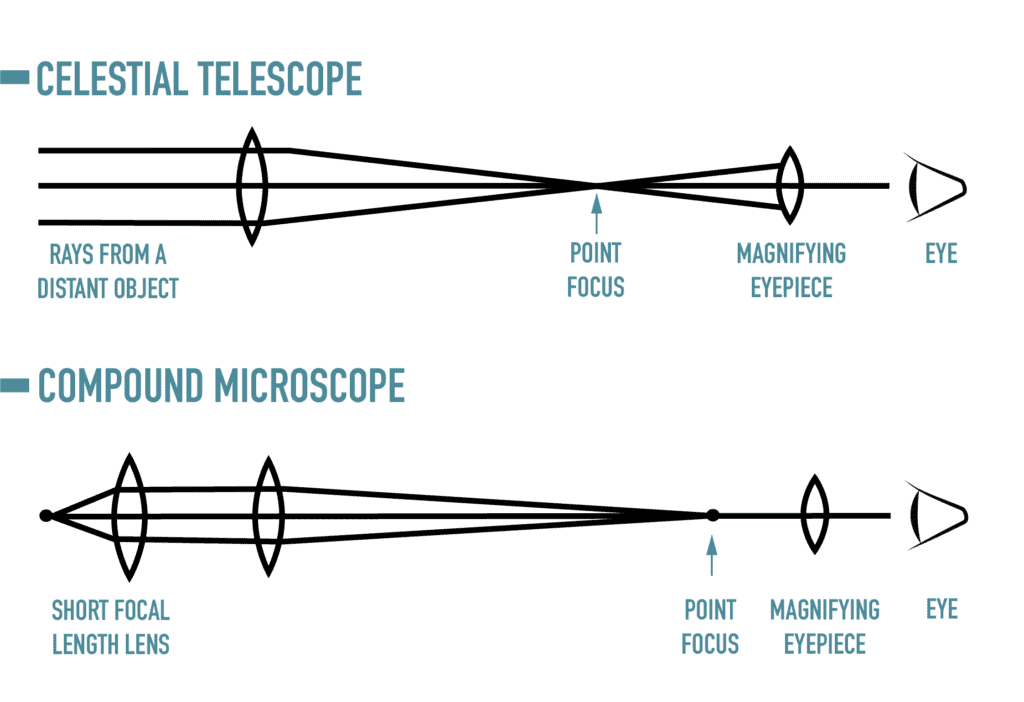The reflector telescopes are composed of mirrors whereas the refractor telescopes are only made of lenses. There is also a third variation called a Schmidt Cassegrain which has become popular throughout the years with its combined system of refractor and reflector lens.
 Reflecting Vs Refracting Telescopes Which To Choose Odyssey Magazine
Reflecting Vs Refracting Telescopes Which To Choose Odyssey Magazine
So what are the advantages and disadvantages of using a mirror over a.

Reflecting telescope vs refracting telescope. The main difference between a reflecting and refracting telescope lies in how they work to magnify the image by manipulating light. 2 an objective lens and 3 an eyepiece. This means that you can set them up pretty much anywhere as long as the skies are clear.
A telescope that uses a mirror as its primary objective is called a reflector telescope or simply reflectors. The reflector telescope uses mirrors for viewing while the refractor uses the lens. 4Reflecting telescopes suffer less from aberrations than refracting telescopes.
Similarly a Lens refracts light and a telescope that uses a lens as its primary objective is called a refractor telescope aka refractor. Telescopes are classified according to the method of how they focus the image into the eyepiece. 2Refracting telescopes require a much purer material than reflecting telescopes.
When it comes to a physical construction cost comparison between a Refractor telescope and a Reflector telescope there is one obvious fact. The main difference between a refracting and a reflecting telescope is that a refracting telescope uses lenses to gather and focus light and a reflecting telescope uses mirrors. A refractor on the other hand will remain collimated for years making it an ideal grab-and-go telescope for those who like to travel to a local dark-sky site or even further abroad.
The construction of a Refractor telescope is relatively easier and simpler than a Reflector telescope. A refracting telescope on the other hand focuses light from one end to another using lens. 4 a viewing mirror holder and.
If you are looking at getting a new Telescope you will notice that there are two main types choose from Reflecting Telescopes and and Refracting Telescopes. A key advantage of the refractor is that there is no central obstruction. The benefits of Newtonian reflecting telescopes over other telescopes include the following.
3 a viewing mirror. They are a lot of differences between both of these categories in terms of performances durability and especially optical quality. This is the feature that differentiates them a lot as the viewing piece is very crucial in deciding the size of an object to view and the corresponding distance.
A refractor needs a sizable mount to manage its large weight whereas a reflector normally would use a simple counterweight. However while a fast refractor will capture images faster at the compromise of a smaller image scale a slower telescope will have a larger image scale but it will take long exposure times. Focal lengths Multiple Mirrors.
Reflecting telescopes are cheaper to make. If you are wondering how they work and the main differences between them then this article will provide you with all that you need to know. Since Mirrors reflect light.
A basic Refractor telescope consists of 1 a tubular body. The two most popular types of telescopes are refractor and reflector telescopes. Reflector telescopes are a little bit heavier in weight.
Refracting telescopes use lenses to focus light while reflecting telescopes use mirrors. While reflectors can have large mirrors for better light collection refractors have good contrast and sharpness are light and transportable and need little to no maintenance. A reflector has other considerations but the most obvious is that fast Newtonians will require precise collimation and a coma corrector and very large models will likely need autoguiding.
A mirror in a reflector normally sits at the base of a telescope and can be fully supported. A reflecting telescope is primarily made up of a mirror that bounces off the light onto a smaller focus area. A refractor telescope is lighter.
Reflector telescopes differ from refractors in that they use a system of mirrors rather than a lens. Reflecting telescopes dont suffer from chromatic aberration. The secondary mirror of the reflector blocks some of the light coming into the tube which reduces the effective aperture.
Compare this to a Reflector telescope which consists of 1 a tubular body. Each have their own uses applications advantages and disadvantages. That said the collimation process for a reflector is quickly learnt and fast to implement at the start of an observing session.
In telescopes with 5 or less aperture the refractor is typically considered to have about a 1-inch advantage. Refractors are generally a bit smaller and more compact in comparison to reflector telescopes. 3Reflecting telescopes can be made much larger than refracting telescopes.
Because the mirror can be fixed onto a metal plate reflecting telescopes can be much bigger than refractors. Manufacturing costs of lenses are higher than that of mirrors which make them more popular. A refractor telescope uses convex bending outwards lenses to collect focus and magnify light.
5Reflecting telescopes are used more for astronomy while refracting telescopes are used more for photography. They offer more convenience in terms of transportation but theyre also not as demanding as reflectors in terms of maintenance due to their predominantly closed-end design. The light collected hits a mirror at the bottom of the telescope and then is reflected back up and then out the side into the eyepiece.
2 an objective mirror.